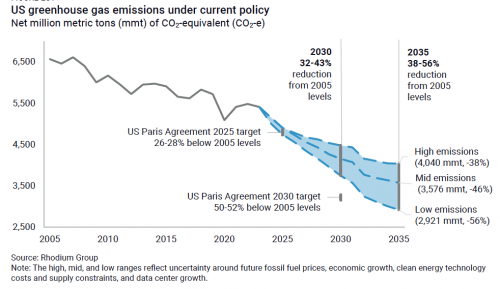New Rhodium Report Shows GHG Declines based on Policy Choices
from Dana Nuccitelli’s Nerd Corner on CCL Community:
Rhodium Group has a new report out, Taking Stock 2024: US Energy and Emissions Outlook. Consistent with other analyses, they anticipate that US climate pollution will reach 32–43% below 2005 levels by 2030 based on current policies. The exact number depends on a number of factors like how successfully the IRA is deployed (e.g., see below about permitting reform), fossil fuel prices, data center growth, and so on.

The report details some of the challenges to successful clean energy deployment:
developers face challenges with long interconnection queues, increasing local opposition to installations, onerous siting and permitting processes, lack of sufficient transmission capacity, continued supply chain constraints, and inflation … [rapid clean energy deployment] will not happen without additional policy action to overcome the non-cost barriers facing clean electricity deployment today, such as siting and permitting, interconnection, and supply chain challenges
Fortunately, a newly-proposed clean energy permitting reform bill would address many of those roadblocks.
Specifically, Rhodium anticipates some good success in decarbonizing the power and transportation sectors by 2035. They think buildings and industry will make very modest progress over that time, agricultural emissions will remain essentially flat, and carbon dioxide removal might increase, but there’s a lot of uncertainty there.

In the US power sector, they think that coal will be gone by 2035 in all scenarios. Renewables will account for 48–74% of our electricity, plus another 14% from nuclear and perhaps 3–4% of gas with carbon capture, and 8–35% of gas without carbon capture. The main question is the ratio of solar to gas power:

They also anticipate that by 2032, 64–76% of new light duty car sales will be electric, though they think the EV share will stagnate after that because the IRA’s tax credit will expire.

They also anticipate that this will make household energy costs will decline by about $2000 per year by 2035, because fueling an EV is so much cheaper than fueling a gasoline car.
Data center and artificial intelligence energy demand is a significant question mark, and could account for 22% of electricity demand growth by 2035 (about half as much as the transition to EVs, and a bit more than electrifying industry or buildings).
Of course the report notes that these projections are based on current climate policies, which “will change by 2035—probably many times over.” They note the outcome of November’s election will of course be a critical deciding factor. And overall,
What’s certain is that more policy action is needed for the US to put itself on track for its 2030 commitment under the Paris Agreement and for deep decarbonization by mid-century.
For example, clean energy permitting reform and a price on carbon pollution! 🤓

